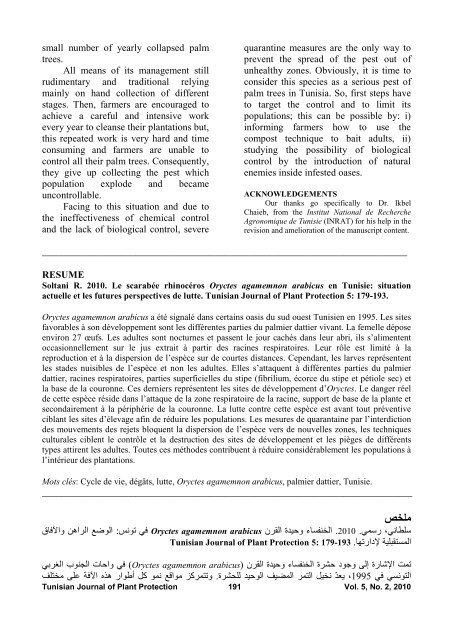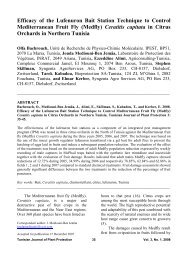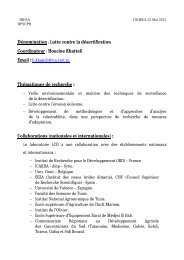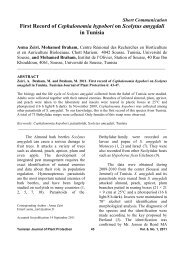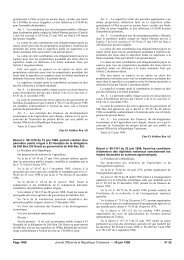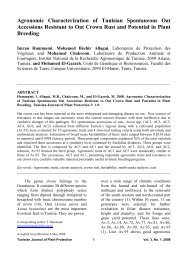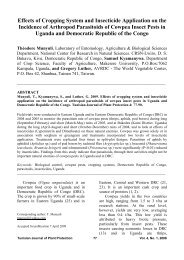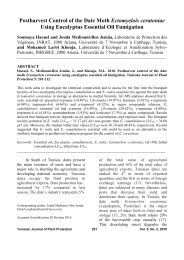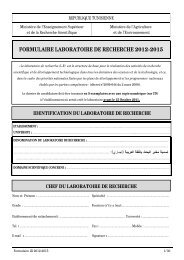The Rhinoceros Beetle Oryctes agamemnon arabicus in ... - Iresa
The Rhinoceros Beetle Oryctes agamemnon arabicus in ... - Iresa
The Rhinoceros Beetle Oryctes agamemnon arabicus in ... - Iresa
You also want an ePaper? Increase the reach of your titles
YUMPU automatically turns print PDFs into web optimized ePapers that Google loves.
small number of yearly collapsed palmtrees.All means of its management stillrudimentary and traditional rely<strong>in</strong>gma<strong>in</strong>ly on hand collection of differentstages. <strong>The</strong>n, farmers are encouraged toachieve a careful and <strong>in</strong>tensive workevery year to cleanse their plantations but,this repeated work is very hard and timeconsum<strong>in</strong>g and farmers are unable tocontrol all their palm trees. Consequently,they give up collect<strong>in</strong>g the pest whichpopulation explode and becameuncontrollable.Fac<strong>in</strong>g to this situation and due tothe <strong>in</strong>effectiveness of chemical controland the lack of biological control, severequarant<strong>in</strong>e measures are the only way toprevent the spread of the pest out ofunhealthy zones. Obviously, it is time toconsider this species as a serious pest ofpalm trees <strong>in</strong> Tunisia. So, first steps haveto target the control and to limit itspopulations; this can be possible by: i)<strong>in</strong>form<strong>in</strong>g farmers how to use thecompost technique to bait adults, ii)study<strong>in</strong>g the possibility of biologicalcontrol by the <strong>in</strong>troduction of naturalenemies <strong>in</strong>side <strong>in</strong>fested oases.ACKNOWLEDGEMENTSOur thanks go specifically to Dr. IkbelChaieb, from the Institut National de RechercheAgronomique de Tunisie (INRAT) for his help <strong>in</strong> therevision and amelioration of the manuscript content.__________________________________________________________________________RESUMESoltani R. 2010. Le scarabée rh<strong>in</strong>océros <strong>Oryctes</strong> <strong>agamemnon</strong> <strong>arabicus</strong> en Tunisie: situationactuelle et les futures perspectives de lutte. Tunisian Journal of Plant Protection 5: 179-193.<strong>Oryctes</strong> <strong>agamemnon</strong> <strong>arabicus</strong> a été signalé dans certa<strong>in</strong>s oasis du sud ouest Tunisien en 1995. Les sitesfavorables à son développement sont les différentes parties du palmier dattier vivant. La femelle déposeenviron 27 œufs. Les adultes sont nocturnes et passent le jour cachés dans leur abri, ils s’alimententoccasionnellement sur le jus extrait à partir des rac<strong>in</strong>es respiratoires. Leur rôle est limité à lareproduction et à la dispersion de l’espèce sur de courtes distances. Cependant, les larves représententles stades nuisibles de l’espèce et non les adultes. Elles s’attaquent à différentes parties du palmierdattier, rac<strong>in</strong>es respiratoires, parties superficielles du stipe (fibrilium, écorce du stipe et pétiole sec) etla base de la couronne. Ces derniers représentent les sites de développement d’<strong>Oryctes</strong>. Le danger réelde cette espèce réside dans l’attaque de la zone respiratoire de la rac<strong>in</strong>e, support de base de la plante etsecondairement à la périphérie de la couronne. La lutte contre cette espèce est avant tout préventiveciblant les sites d’élevage af<strong>in</strong> de réduire les populations. Les mesures de quaranta<strong>in</strong>e par l’<strong>in</strong>terdictiondes mouvements des rejets bloquent la dispersion de l’espèce vers de nouvelles zones, les techniquesculturales ciblent le contrôle et la destruction des sites de développement et les pièges de différentstypes attirent les adultes. Toutes ces méthodes contribuent à réduire considérablement les populations àl’<strong>in</strong>térieur des plantations.Mots clés: Cycle de vie, dégâts, lutte, <strong>Oryctes</strong> <strong>agamemnon</strong> <strong>arabicus</strong>, palmier dattier, Tunisie.___________________________________________________________________________<strong>Oryctes</strong> <strong>agamemnon</strong> <strong>arabicus</strong>.2010Tunisian Journal of Plant Protection 5: 179-193ملخصسلطاني، رسمي.المستقبلية لإدارتها.الخنفساء وحيدة القرنفي تونس: الوضع الراهن والآفاقفي واحات الجنوب الغربيتمت الإشارة إلى وجود حشرة الخنفساء وحيدة القرنالتونسي في نخيل التمر المضيف الوحيد للحشرة. وتتمرآز مواقع نمو آل أطوار هذه الآفة على مختلف(<strong>Oryctes</strong> <strong>agamemnon</strong> <strong>arabicus</strong>)1995، يعدّTunisian Journal of Plant Protection 191 Vol. 5, No. 2, 2010


